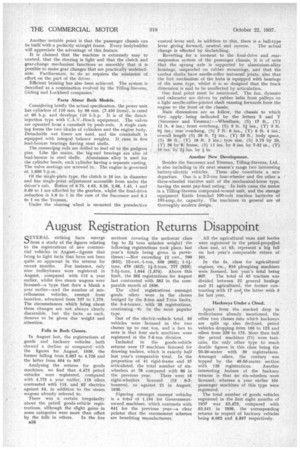August Registration Returns Disappoint
Page 68

If you've noticed an error in this article please click here to report it so we can fix it.
QEVERAL striking facts emerge s..)from a study of the figures relating to the registrations of new commercial vehicles in August—figures that bring to light facts that have not been quite so apparent in the returns for recent months. For instance, only nine trolleybuses were registered in August, compared with 112 a year earlier, whilst five steam wagons were licensed—a 'type that drew a blank a year earlier—and the number of miscellaneous vehicles, exempt from taxation, advanced from 737 to 1,275. The circumstances whith bring about these changes are not always clearly discernible, but the facts, as such, deserve to be given due weight and attention.
Falls in Both Classes.
Tri August last, the registrations of goods and hackney vehicles both showed a decline as compared with the figures for August, 1936, the former falling from 6,057 to 4,726 and the latter from 504 to 307.
Analysing the returns for goods machines, we find that 4,473 petrol vehicles were registered, compared with 4,775 a year earlier, 118 oilers contrasted with 115. and 62 elect-rics against 54, in addition to the steam wagons already referred to.
There was a certain irregularity about the petrol goads-vehicle registrations, although the slight gains in some categories were more than offset by the falls in others. In the five
sections covering the motorcar class (up to 2+ tons unladen weight) the following registrations took place, last year's totals being given in parentheses :—Not exceeding 12 cwt., 700 (833); 12-cwt.-1-ton, 508 (605); 1-1+tons, 479 (452); 1+-2-tons, 777 (929); 2-2i-tons, 1,644 (1,674). Above this limit, the 365 registrations for August last contrasted with 382 in the comparable month of 1936.
The chief registrations amongst -goods oilers were in the classes bridged by the 3-ton and 7-ton limits, the 3-4-tonner, with 35 registrations, continuing to be the most popular type. Out of the electric-vehicle total, 50 vehicles were licensed in the two classes up to one ton, and a fact to note is that four such machines were registered in the 7-8-ton division.
Included in the goods-vehicle returns were 17 machines licensed for drawing trailers, which is exactly half last year's comparable total. In the proportion of 41 rigid-frame and 37 articulated, the total number of sixwheelers at 78 compared with 86 in the previous year. There were 16 eight-wheelers licensed (13 6-7tonners), as against 21 in August, 1936.
Figuring amongst exempt vehicles is a total of 1,194 for Government-. owned machines, which contrasts with 641 for the previous year—a clear pointer that the rearmament schemes are benefiting manufacturers: All the agricultural vans and lorries were registered in the petrol-propelled class and, at 63, represent a big fall on last year's comparable return of 101.
In the 5s. class for agricultural engines, etc., 816 ploughing machines were licensed, last year's total being
607. The total of 43 tractors was divided between 22 general haulage and 21 agricultural, the former contrasting with 17 and/ the latter with 3 for last year, Hackneys Under a Cloud.
Apart from the marked drop in trolleybuses already mentioned, the other two classes into which hackneys are split up also declined, petrol vehicles dropping from 166 to 123 and oilers from 226 to 175. More than half the petrol machines (71) were taxicabs, the only other type to reach double figures in this class being the 20-26-seater with 30 registrations. Amongst oilers, the century was topped by the 48-56-seater section with 129 registrations. Another interesting feature of the hackney returns is that no six-wheelers were licensed, whereas a year earlier 104 passenger machines of this type were registered. .
The total number of goods vehicles registered in the first eight months of 1937 was 52,473, compared with 53,541 in 1936, the corresponding returns in respect of hackney vehicles being 6,052 and 5,897 respectively.
























































































































